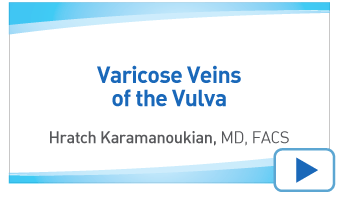
One in 10 women develop vulvar varicose veins (veins on the vulva, veins on the external genitalia) during pregnancy. Vulvar varicose veins typically develop in the second trimester of pregnancy and cause symptoms for approximately a year or more after delivery.

Anatomically, veins of the vulva (normal healthy vulvar veins) have a rich network of communicating branches with veins arising in the wall of the pelvis, and also communicate and anastomose with the venous drainage of the female organs. They also have communicating branches with the internal iliac veins and external iliac venous system. As well, they have been shown using venography and magnetic resonance venography (MRV) to communicate with the medial aspect of the thigh via the perineal veins.
It was surmised for a long time that varicose veins during pregnancy is related to an increase in circulating volume and that veins of the vulva develop because of the undue and increased pressure from the ever enlarging uterus and the increase in circulating venous volume. More recent studies, however, have shown that varicose veins of the vulva develop because there is an increase in the circulating levels of estrogen and progesterone in the pregnanct state.
Vulvar varicose veins alter quality of life as measured by quality of life indicators (QOL), an objective parameter used to determine the effect of a disease process in a patient. They can cause a sense of heaviness in the groin area, priritis (itching) from inflammation and discomfort with physical activity and pain during the resting state. They have also been noted to cause dyspareunia (pain with intercourse) for a year or more after delivery. The treatment of vulvar varicose veins is targeted in the period after delivery as they are not considered to be urgent or emrgent in nature during pregnancy.
Treatment
In our practice, we limit treatment to patients who continue to have symptoms 6-12 months after pregnancy. Our preferred treatment of choice is foam sclerotherapy with or without ultrasound guidance.